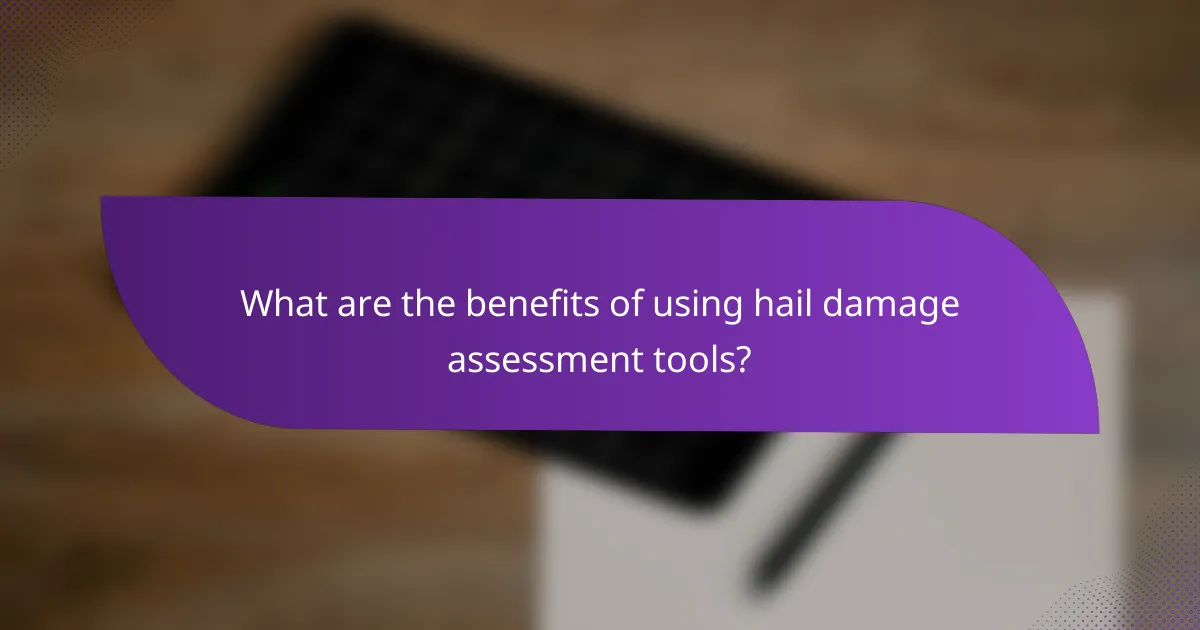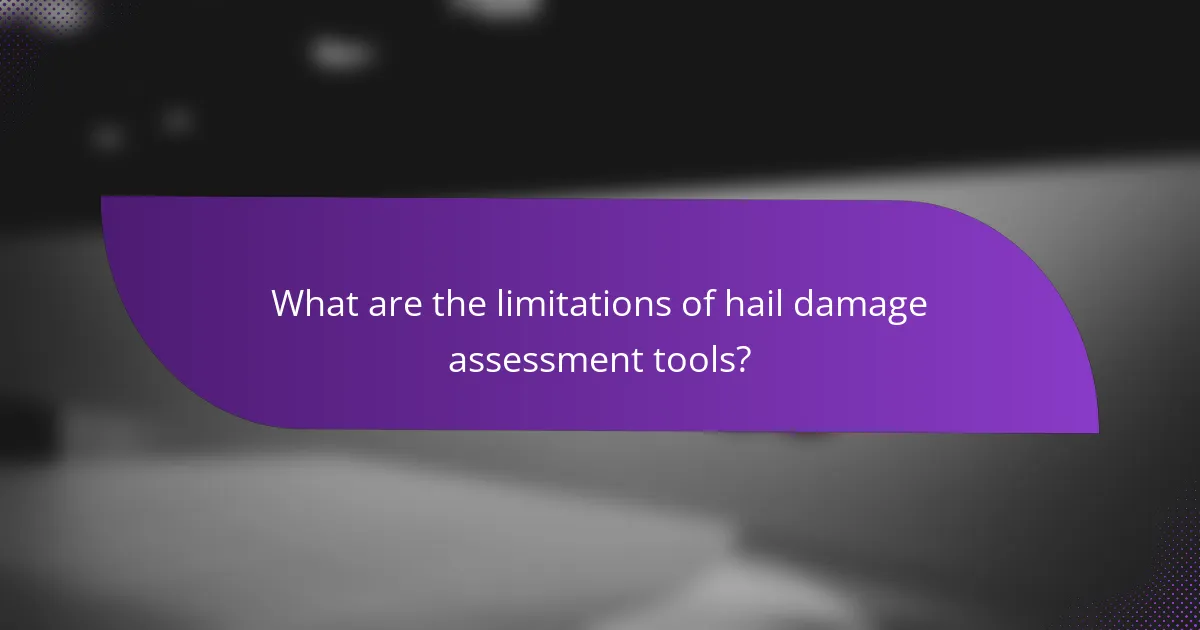Hail damage assessment tools are essential for accurately evaluating the impact of hail on properties and vehicles. By utilizing technologies that gather and analyze data, these tools assist property owners and insurers in determining the extent of damage, which is vital for insurance claims and repair decisions. When choosing the right tool, it’s important to prioritize features that enhance accuracy, usability, and integration with existing systems to ensure reliable results.

What are the best hail damage assessment tools in Ireland?
The best hail damage assessment tools in Ireland include HailTrace, AccuWeather Hail Map, and HailReport. These tools provide valuable insights into hail events, helping property owners and insurers evaluate potential damage effectively.
HailTrace
HailTrace is a comprehensive tool that uses advanced radar technology to track hailstorms in real-time. It provides detailed maps showing the size and path of hail, which can be crucial for assessing damage to properties.
This tool is particularly useful for insurance adjusters and contractors, as it allows them to pinpoint affected areas and estimate repair costs. Subscription plans vary, but many users find the investment worthwhile for the accuracy and detail it offers.
AccuWeather Hail Map
AccuWeather Hail Map is a user-friendly tool that provides visual representations of hailstorm activity across Ireland. It offers historical data and forecasts, helping users anticipate potential hail damage.
This tool is accessible online and can be used for free, although premium features may require a subscription. Its simplicity makes it a good choice for homeowners wanting to monitor hail activity without extensive technical knowledge.
HailReport
HailReport is a community-driven platform that allows users to report hail events and view reports from others. This tool can provide localized information about hail size and damage, which is beneficial for assessing risk in specific areas.
While it may not have the advanced features of HailTrace, HailReport’s community aspect can offer real-time insights and help users understand the impact of recent storms. It’s a free resource, making it accessible for anyone interested in tracking hail damage in their locality.

How do hail damage assessment tools work?
Hail damage assessment tools evaluate the impact of hail on structures and vehicles using various technologies to gather and analyze data. These tools help determine the extent of damage, which is crucial for insurance claims and repair decisions.
Data collection methods
Data collection for hail damage assessment typically involves remote sensing technologies, such as drones, satellites, and ground-based sensors. Drones equipped with high-resolution cameras can capture detailed images of affected areas, while satellites provide broader coverage to identify hailstorms and their paths.
Ground-based sensors, including weather stations, measure hail size, intensity, and duration. This combination of methods allows for a comprehensive understanding of hail events and their potential damage.
Analysis algorithms
Analysis algorithms process the collected data to identify and quantify damage. These algorithms often use machine learning techniques to classify damage severity based on image recognition and historical data. For example, they can distinguish between minor dents and significant structural issues.
When selecting an assessment tool, consider the algorithm’s accuracy and the quality of the training data used. Tools that leverage extensive datasets tend to provide more reliable assessments, which can significantly impact repair costs and insurance evaluations.

What are the key features to consider in hail damage assessment tools?
When selecting hail damage assessment tools, it’s essential to focus on features that enhance accuracy, usability, and integration with other systems. These aspects will ensure that the tools provide reliable data, are easy to navigate, and can work seamlessly with existing software.
Accuracy of data
Accuracy is crucial in hail damage assessment tools, as it directly impacts the reliability of the damage evaluation. Look for tools that utilize high-resolution imagery and data from reputable sources, such as satellite or aerial surveys. Tools that provide real-time updates or historical data comparisons can also enhance accuracy.
Consider tools that offer validation features, allowing users to cross-check assessments with on-site inspections. This can help identify discrepancies and ensure that the reported damage aligns with actual conditions.
User interface
A user-friendly interface is vital for effective hail damage assessment. Tools should have intuitive navigation, clear labeling, and accessible features that allow users to quickly input data and retrieve information. A well-designed interface minimizes the learning curve and enhances productivity.
Look for tools that offer customizable dashboards, enabling users to prioritize the information most relevant to their needs. This flexibility can improve the overall user experience and streamline the assessment process.
Integration capabilities
Integration capabilities determine how well a hail damage assessment tool can work with other systems, such as insurance software or customer relationship management (CRM) platforms. Tools that support API connections or data export options can facilitate smoother workflows and data sharing.
Ensure that the tool can integrate with existing technologies used in your organization. This compatibility can save time and reduce errors by allowing for seamless data transfer between systems, enhancing overall efficiency in the damage assessment process.

How much do hail damage assessment tools cost?
The cost of hail damage assessment tools varies widely based on features and pricing models, typically ranging from low tens to several hundred dollars. Users should consider their specific needs and budget when selecting a tool, as both subscription and one-time purchase options are available.
Subscription pricing models
Subscription pricing models for hail damage assessment tools usually involve monthly or annual fees, providing access to updated features and support. These plans can range from around $10 to $50 per month, depending on the tool’s capabilities and the level of service offered.
One advantage of subscription models is the continuous updates and improvements, which can be crucial for staying current with the latest technology and data. However, users should evaluate whether the ongoing costs align with their usage frequency and budget constraints.
One-time purchase options
One-time purchase options for hail damage assessment tools typically involve a higher upfront cost, often between $100 and $500. These tools may offer a comprehensive set of features without recurring fees, making them appealing for users who prefer a single investment.
While one-time purchases can be economical in the long run, users should ensure that the tool remains relevant and functional over time, as updates may not be included. It’s essential to assess the tool’s longevity and support options before committing to a one-time purchase.

What are the benefits of using hail damage assessment tools?
Hail damage assessment tools provide significant advantages in evaluating the extent of damage to properties, particularly roofs and vehicles. These tools enhance accuracy, save time, and often lead to better insurance claims outcomes.
Improved claim accuracy
Using hail damage assessment tools can greatly improve the accuracy of insurance claims by providing precise evaluations of the damage. Tools such as drones and specialized software can capture detailed images and data, allowing for a thorough analysis of the affected areas.
Accurate assessments help ensure that policyholders receive fair compensation based on the actual extent of the damage. This reduces the likelihood of disputes between homeowners and insurance companies, leading to smoother claim processes.
Time efficiency
Hail damage assessment tools streamline the inspection process, significantly reducing the time required to evaluate damage. Traditional methods can take hours or even days, while modern tools can often provide results in a matter of minutes.
For instance, using a drone can cover large areas quickly, allowing for rapid data collection and analysis. This efficiency not only benefits homeowners but also helps insurance adjusters process claims more swiftly, improving overall customer satisfaction.

What are the limitations of hail damage assessment tools?
Hail damage assessment tools have several limitations that can affect their accuracy and reliability. These include geographic coverage, data update frequency, and the quality of the underlying data used for assessments.
Geographic coverage limitations
Many hail damage assessment tools are limited in their geographic coverage, meaning they may not provide accurate assessments for all regions. For instance, tools may focus primarily on urban areas while neglecting rural locations, leading to incomplete data. Users should verify whether the tool they choose covers their specific area of interest.
Additionally, some tools may not account for local variations in hail patterns, which can differ significantly even within short distances. It’s crucial to select a tool that offers comprehensive coverage for your locality to ensure accurate assessments.
Data update frequency
The frequency with which data is updated can significantly impact the reliability of hail damage assessments. Tools that rely on outdated information may not reflect recent weather events or changes in local conditions. Users should look for tools that provide real-time or near-real-time updates to ensure they are working with the most current data available.
In practice, some tools may update their data daily, while others might do so weekly or even less frequently. Understanding the update schedule can help users gauge the tool’s effectiveness in providing timely assessments after a hail event.

How to choose the right hail damage assessment tool for your needs?
Selecting the appropriate hail damage assessment tool involves understanding your specific requirements, budget, and the features that will best serve your situation. Consider factors such as ease of use, accuracy, and whether the tool provides comprehensive reporting capabilities.
Assessing user requirements
Begin by identifying the primary purpose of the hail damage assessment tool. Are you a homeowner looking to evaluate damage for insurance claims, or a contractor needing to provide detailed reports? Understanding your role will guide your choice.
Next, consider the features that matter most to you. For instance, some tools offer real-time data analysis, while others focus on visual inspections. If you need quick assessments, look for tools that provide mobile access and user-friendly interfaces.
Lastly, evaluate your budget. Affordable options are available, but ensure they meet your quality standards. Tools priced in the low hundreds of USD may suffice for basic assessments, while more advanced tools can range into the thousands, offering enhanced features and support.
